“Global Immersive Virtual Reality Market to reach a market value of USD 88.3 Billion by 2031 growing at a CAGR of 25.6%”
The Global Immersive Virtual Reality Market size is expected to reach $88.3 billion by 2031, rising at a market growth of 25.6% CAGR during the forecast period.
VR allows medical personnel and students to interact with virtual patients, diagnose conditions, and practice surgical procedures in a risk-free environment, all while providing highly realistic simulations. This hands-on experience enhances learning and skill development. Surgeons and medical practitioners can use VR to rehearse complex procedures and refine their techniques before performing them on real patients. This preparation helps improve precision and outcomes in actual surgeries. Thus, the healthcare segment procured 13% revenue share in the immersive virtual reality market in 2023.
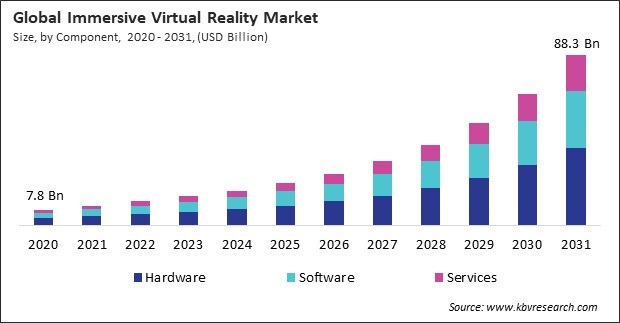
The major strategies followed by the market participants are Partnerships as the key developmental strategy to keep pace with the changing demands of end users. For instance, In September, 2024, Google LLC partnered with Infinite Reality, an American XR company, to provide AI-powered 3D and immersive solutions for e-commerce, sports, entertainment, education, and customer care. The partnership enables brands to create virtual worlds, enhance engagement, and optimize monetization, meeting the growing demand for immersive digital experiences from Gen Z and Millennials. Additionally, In December, 2023, Meta Platforms, Inc. partnered with Telefónica, a telecommunications company, to promote mixed reality among elderly people. The partnership reinforces Meta's goal to provide everyone with the benefit of immersive technologies.
Based on the Analysis presented in the KBV Cardinal matrix; Apple, Inc., Google LLC and Microsoft Corporation are the forerunners in the Immersive Virtual Reality Market. Companies such as Meta Platforms, Inc., Samsung Electronics Co., Ltd., Qualcomm Incorporated are some of the key innovators in Immersive Virtual Reality Market. In April, 2022, Meta Platforms, Inc. signed a partnership with Unity, a video game software development company, to provide immersive learning experiences using XR. The partnership would lead to new opportunities for learners.
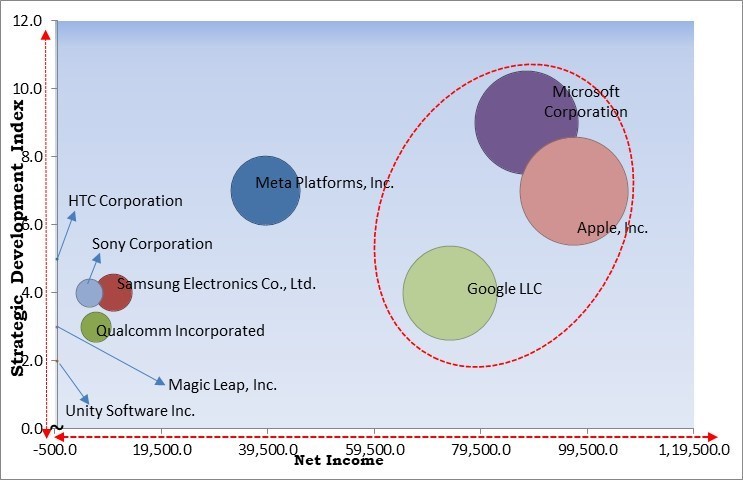
The ability to experience virtual simulations that mimic real-life scenarios, such as virtual travel or home tours, attracts consumers looking for more immersive and realistic experiences. In conclusion, rising consumer interest in immersive and interactive experiences drives the market’s growth.
Additionally, The Metaverse drives the need for user-friendly and accessible VR solutions, encouraging the development of affordable and easy-to-use VR products that appeal to a wider audience. Therefore, the growing penetration of the metaverse worldwide is driving the market’s growth.
The high development cost can limit the number of content creators and the diversity of available VR experiences. Developing VR content often requires specialized skills and expertise, including knowledge of VR programming, graphics design, and user experience optimization. Hiring skilled professionals adds to the overall cost of content creation. Thus, VR hardware and software development costs hamper the market’s growth.
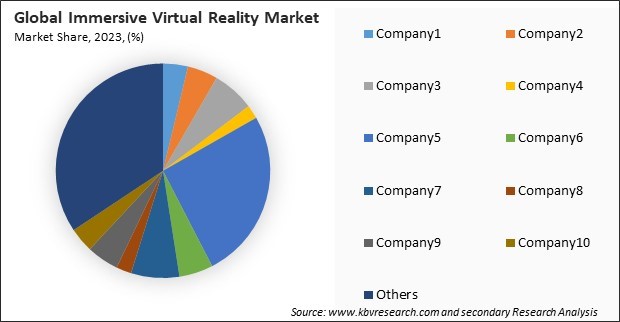
The leading players in the market are competing with diverse innovative offerings to remain competitive in the market. The above illustration shows the percentage of revenue shared by some of the leading companies in the market. The leading players of the market are adopting various strategies in order to cater demand coming from the different industries. The key developmental strategies in the market are Partnerships, Collaborations & Agreements.
Based on component, the market is divided into hardware, software, and services. In 2023, the hardware segment garnered 47% revenue share in the market. VR hardware, including headsets, controllers, sensors, and haptic feedback devices, provides the core technology required to deliver immersive experiences.
On the basis of technology, the market is segmented into non-immersive and semi & fully immersive. In 2023, the non-immersive segment attained 21% revenue share in the immersive virtual reality market. Non-immersive VR solutions, such as 360-degree videos and basic VR applications, are generally less expensive.
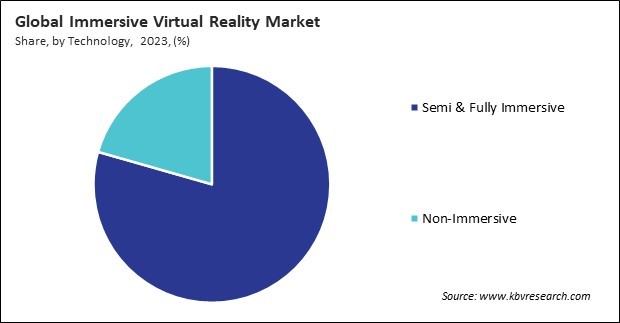
Based on device, the market is categorized into head mounted display, gesture tracking device, and projectors & display wall. The gesture tracking device segment witnessed 23% revenue share in the market in 2023. Gesture tracking devices enable users to interact with virtual environments using natural hand and body movements.
By end-use, the market is classified into aerospace & defense, manufacturing, automotive, education, media & entertainment, gaming, healthcare, retail & e-commerce. The education segment acquired 11% revenue share in the market in 2023. VR transforms traditional learning methods by making lessons more interactive and engaging.
Free Valuable Insights: Global Immersive Virtual Reality Market size to reach USD 88.3 Billion by 2031
Region-wise, the market is analyzed across North America, Europe, Asia Pacific, and LAMEA. In 2023, the Europe region generated 29% revenue share in the market. European governments fund and support VR projects through various grants, subsidies, and research programs.
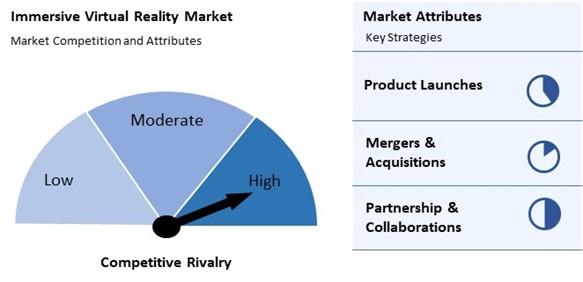
The market is highly competitive, driven by innovation in display technology, motion tracking, and exclusive content. It spans diverse applications, including gaming, healthcare, education, and enterprise solutions. Barriers to entry are significant due to high R&D costs and the complexity of development. Global adoption rates vary, influenced by infrastructure and cultural factors. Success in the market depends on delivering superior user experience, high-quality content, and strategic pricing, with innovation being key to gaining and maintaining market share.
| Report Attribute | Details |
|---|---|
| Market size value in 2023 | USD 14.9 Billion |
| Market size forecast in 2031 | USD 88.3 Billion |
| Base Year | 2023 |
| Historical Period | 2020 to 2022 |
| Forecast Period | 2024 to 2031 |
| Revenue Growth Rate | CAGR of 25.6% from 2024 to 2031 |
| Number of Pages | 316 |
| Number of Tables | 483 |
| Report coverage | Market Trends, Revenue Estimation and Forecast, Segmentation Analysis, Regional and Country Breakdown, Competitive Landscape, Market Share Analysis, Porter’s 5 Forces Analysis, Company Profiling, Companies Strategic Developments, SWOT Analysis, Winning Imperatives |
| Segments covered | Component, Device, Technology, End-use, Region |
| Country scope |
|
| Companies Included | Microsoft Corporation, HTC Corporation, Meta Platforms, Inc., Samsung Electronics Co., Ltd. (Samsung Group), Sony Corporation, Unity Software Inc., Magic Leap, Inc., Apple, Inc., Qualcomm Incorporated (Qualcomm Technologies, Inc.), and Google LLC |
By Component
By Device
By Technology
By End-use
By Geography
This Market size is expected to reach $88.3 billion by 2031.
Rising consumer interest in immersive and interactive experiences are driving the Market in coming years, however, High costs of VR hardware and software development restraints the growth of the Market.
Microsoft Corporation, HTC Corporation, Meta Platforms, Inc., Samsung Electronics Co., Ltd. (Samsung Group), Sony Corporation, Unity Software Inc., Magic Leap, Inc., Apple, Inc., Qualcomm Incorporated (Qualcomm Technologies, Inc.), and Google LLC
The expected CAGR of this Market is 25.6% from 2024 to 2031.
The Head Mounted Display segment is leading the Market by Device in 2023; thereby, achieving a market value of $52.9 billion by 2031.
The North America region dominated the Market by Region in 2023, and would continue to be a dominant market till 2031; thereby, achieving a market value of $34.8 billion by 2031.
Our team of dedicated experts can provide you with attractive expansion opportunities for your business.
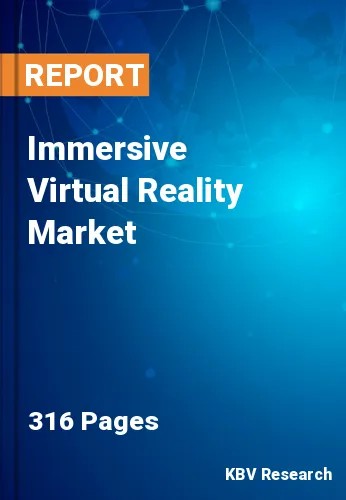
 Drivers
Drivers
 Restraints
Restraints
 Opportunities
Opportunities
 Challenges
Challenges
